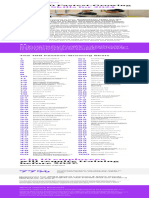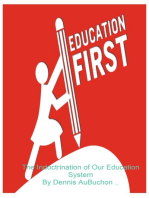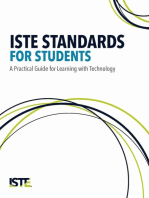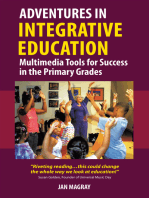Repository System For Tertiary Institutions in Malaysia: Chapter 1: Introduction
Uploaded by
Oche MichaelRepository System For Tertiary Institutions in Malaysia: Chapter 1: Introduction
Uploaded by
Oche MichaelREPOSITORY SYSTEM FOR TERTIARY INSTITUTIONS IN MALAYSIA
Chapter 1: Introduction
This research project presents a solution involved in repository systemsprojects that aim to improve humans, education and environment. It considers the option of using repository systems to improve the educational quality in Malaysia. The aim is to develop a
repository data centre to assist the tertiary institutions in monitoring the performance of students in many geographical areas in this country Malaysia. This research will pave a way for accurate budgeting, forecasting on educational sector and highlight ways to improve educational quality and performance in the country. This forms the basis of building a Repository System for Tertiary Institutions in educational environment with specific reference to Malaysia.
1.1
Education
Education is not only the process of impacting or acquiring general or specific knowledge but is also the tendency of building capacity or powers for reasoning and judgement and act of preparing oneself or others intellectually to mature life (Longman, 2010). Many people always view schools in a traditional and formal sense. There is no definitive definition of education, many think that education occurs in different forms and environment while some think that education only take place in the class or lecture room. Definition of education may differ from one person or the other, but education can be intuitively defined as a basic human right. It is believed that when this right is permitted,
growth and development is rapidly seen in the society to constitute to good living standard. There are many issues surrounding education such as inadequate of resources, poor founding, etc. It is the obligation of the people, group andgovernment to critically think about these issues confronting education and eventually come up with a better solution to improve education in the world. In 1990, UNESCO launched Education for All (EFA) (Ann, 2009);the movement to provide quality education for all children, youths and adults by the year 2015. It is unfortunate that in most of the countries, there are many issues that are preventing the improvement of the quality of education which therefore questions if the objectives of UNESCO towards EFA can be realized or not. One of the commonest ways to deal with the above mention problem lies in the access towards technology. It is an indisputable fact that access to technology can serve as a great tool for education. When one fails to access this tool, he or she suffers behind. So education as we have seen does not only promote individual development, rather it offers the general growth of the entire community, therefore providing a place for people to interact, socialize and unify the society.
1.2
Education in Malaysia
Malaysia a multi-ethnic society country located in the tropics of Southeast Asia. With the great ambition to become a developed Nation by 2020, many developments are putting Malaysia on the worlds map as she focuses on becoming a knowledge base economy country. In order to ensure educational quality and standard, Malaysian government in 1995 to 1997 initiated major educational reforms by establishing a legislative body to oversee all the levels of education, from the pre-school to tertiary education, <http://www.mpm.edu.my>. At the same time, Pre School to secondary education is
under the supervision of the Ministry of Education (MOE), while the post-secondary education is put under the jurisdiction of the Ministry of Higher Education (MOHE). Malaysia has become a centre of educational excellence especially in the South East Asia, which is motivated by the effort of the government in seeing educational excellence as its responsibility to better citizenry and the country as a whole, <http://www.mpm.edu.my>. According to the Minister of Higher Education, Datuk Mustapha Mohamed in 2007, he said Our vision is to make Malaysia the centre of educational excellence. Malaysia is not relenting in realizing this vision as targeted by 2015.
1.3
Tertiary Education in Malaysia
In Malaysia there are 647 High Education Institution (HEI). This consists of 20 public universities and 627 higher education institutions (Ken, 2010).
1.4
Definition of Repository System
A repository systemmay be defined as a centralized system where data is collected, stored, retrieved, disseminated and maintained which can be access by multiple users locally or remotely (Mikeal, 2009). A repository system can be a place where
multiple databases or files are located for distribution over a network or a location that is directly accessible to the users without having to travel across a network (Mikeal, 2009).Furthermore, a full-fledged repository system is on principle a database management system (DBMS) with some special functionality to administer meta-data (Herbst, 1995). This includes the capability to specify meta-models, to customize the user interface, and to implement appropriate verification mechanisms and generators.
1.5
Problem Statement
In Malaysia, higher education is generally seen as a major foundation in implementing the complex process of globalization. It is certainly known that the advent of globalization,
advanced information technology and higher education services have already been expanding beyond territorial especially in educational environment (Arokiasamy, 2010). Open access or in other words, information sharing has been widely encouraged in Malaysia especially in tertiary institutions. One of the greatest champions in the open access here in Malaysia is the libraries and Librarian. They initiated the promotion of access to information by implementing an institutional repository (Azmi, 2009).The Malaysian National Library is aimed to implement a repository of information resources based on bibliographic and non-bibliographic records of libraries (Azmi, 2009). According to Azmi (2009), there have been initiative to promote the access of information by implementing an institutional repository; but there have not been a repository system implemented to focus on the intellectual performance of student in tertiary institutions in Malaysia. It is clear fact that developing such system will ensure the following benefits: Repository system for tertiary institution does not only boost the quality of educational system, it goes far to contribute as a logical extension of a universitys or colleges core mission and as a channel through which to increase institutional visibility. The responsibility of communication between the MOHE and all the tertiary institutions will be strengthen and positioning the tertiary institutions with broader context of its markets or communities. It is important to note that every higher institution is committed to academic excellence and scientific progress. One may ask if there is any system to measure or prove this assertion. The repository systems will not only answer this question but it will also provide university administrators with demonstrable evidence of the institutions quality, thus helping every institution reinforce on institutions brand position and prestige.
Repository technology system, by capturing, preserving, and disseminating institutional collective intellectual information or records, serves as meaningful indicator of academic quality and merit. Repository system is not only a desired technology for tertiary institutions in Malaysia but it also present itself as a potential prediction tool for future analysis of institutional goal or initiatives.
1.6
Research Objectives
The research objectives of the current study are: To assess the status of repository system in Malaysia, specifically in the relation to tertiary institutions. To design and develop a repository system for tertiary institutions in Malaysia.
1.7
Project Scope
This project aims to implement the repository system for tertiary institutions in Malaysia that will be capable of carrying out different analysis and prediction services. An easy to use user interface will be employed to ensure user friendly system to all users. The scope also integrate business intelligent tool to produce different forms reports based on the following: Attendance of the students per semester or yearly basis for the benefit of visa extension,etc. for international students. This report is mostly asked by the Immigration Department during visa or passport renewal. Performance of the student for educational quality purposes, rating and Key Performance Indicator (KPI). The report from this session will directly go to MOHE.
Population of students based on different state in Malaysia or population of foreign students from different countries studying in Malaysia. With the application of cubes structure as one of the important tools used in multidimensional data warehousing, information on any or group of students can be produced in given time range.
1.8
Organization of Thesis
Chapter 1: Introduction This chapter provides overview of educational system in Malaysia specifically on the tertiary institutions. The objectives and scope are also discussed in this chapter. Chapter 2: Literature Review The literature review for this research project gives the overview of repository system, types of repository data, intelligent information and existence of repository systems around the world. It also gives the methodology and implementation details used in some existing repository systems. Chapter 3: Methodology This chapter discusses the research methodology used for this study, the data collection and the method of data collection. Chapter 4: Data Analysis In this chapter, discussion is about data analysis. The data collected from tertiary institutions were tabulated, analysed and discussed in details. It also analysed about system review on repository system.
Chapter 5: System Analysis and Design The system design is conferred in this chapter. Here Web Development Method (WSDM) was used to carry out the design modeling. The Data Centre framework was discussed with respect to the proposed framework and prototype of Repository System.The Data Flow Diagram (DFD), activity diagram, database design, classes and function modules were also discussed in this chapter. Chapter 6: Implementation and Testing In this chapter, the database, classes and function implementations were analysed. The implementation of the repository system is narrated here; system testing which was done by the same contributors who participated in survey questionnaire.
Chapter 7: Conclusion The project result base on the objectives of this study wasdeliberated in this chapter. The limitation and future work having considered the importance were also discussed here.
You might also like
- Sunbeam Popcorn Maker FPSBPP7310 FPSBPP731660% (10)Sunbeam Popcorn Maker FPSBPP7310 FPSBPP73169 pages
- Wiley - Operations Management - An Integrated Approach, 7th Edition - 978-1-119-49706-6No ratings yetWiley - Operations Management - An Integrated Approach, 7th Edition - 978-1-119-49706-63 pages
- Ford Escape 4wd Workshop Manual v6 3 0l 2008100% (4)Ford Escape 4wd Workshop Manual v6 3 0l 20087,556 pages
- 2019 Book EssentialsOfBusinessAnalytics PDF93% (14)2019 Book EssentialsOfBusinessAnalytics PDF971 pages
- Udemy 2024 Learning Trends Top 100 Surging Skills Infographic100% (1)Udemy 2024 Learning Trends Top 100 Surging Skills Infographic1 page
- Education Reimagined: Leading Systemwide Change with the ISTE StandardsFrom EverandEducation Reimagined: Leading Systemwide Change with the ISTE StandardsNo ratings yet
- ISTE Standards for Educators: A Guide for Teachers and Other ProfessionalsFrom EverandISTE Standards for Educators: A Guide for Teachers and Other Professionals5/5 (1)
- Strategic Leadership: Realizing Student Aspiration OutcomesFrom EverandStrategic Leadership: Realizing Student Aspiration OutcomesNo ratings yet
- The Impact of Facilities On Student'S Academic Achievement: November 2019No ratings yetThe Impact of Facilities On Student'S Academic Achievement: November 201914 pages
- Knowledge Sharing Tutorial: Where Technology Is Advancing, Economies Challenged, and Communities Evolving, Nothing Is More Essential Than the Development of Learning Resources in School and at WorkFrom EverandKnowledge Sharing Tutorial: Where Technology Is Advancing, Economies Challenged, and Communities Evolving, Nothing Is More Essential Than the Development of Learning Resources in School and at WorkNo ratings yet
- Global Education Reform: The Universe Is Governed by a Sequence of Realms; Hence, Global Education Reform Is a Dignified Path to Peace and Unity, a Promised Corridor for the Eradication of Lingering Human Prejudice, Discrimination, Injustice, and Language Barriers.From EverandGlobal Education Reform: The Universe Is Governed by a Sequence of Realms; Hence, Global Education Reform Is a Dignified Path to Peace and Unity, a Promised Corridor for the Eradication of Lingering Human Prejudice, Discrimination, Injustice, and Language Barriers.No ratings yet
- Watching Students Glo: General Learner Outcomes Build CharacterFrom EverandWatching Students Glo: General Learner Outcomes Build CharacterNo ratings yet
- The Evolution of Instructional Technology: Overcoming Apprehension About the Use of Technology in the Classroom for InstructionFrom EverandThe Evolution of Instructional Technology: Overcoming Apprehension About the Use of Technology in the Classroom for InstructionNo ratings yet
- The Impact of Facilities On Student'S Academic AchievementNo ratings yetThe Impact of Facilities On Student'S Academic Achievement13 pages
- Unlocking the Gates: How and Why Leading Universities Are Opening Up Access to Their CoursesFrom EverandUnlocking the Gates: How and Why Leading Universities Are Opening Up Access to Their Courses3.5/5 (4)
- ISTE Standards for Students: A Practical Guide for Learning with TechnologyFrom EverandISTE Standards for Students: A Practical Guide for Learning with TechnologyNo ratings yet
- Inside the Higher Education Space: Governance, Quality Culture and Future Directions - A Malawi PerspectiveFrom EverandInside the Higher Education Space: Governance, Quality Culture and Future Directions - A Malawi PerspectiveNo ratings yet
- Free Agent Learning: Leveraging Students' Self-Directed Learning to Transform K-12 EducationFrom EverandFree Agent Learning: Leveraging Students' Self-Directed Learning to Transform K-12 EducationNo ratings yet
- Tamansiswa Accounting Journal International: Volume 1, No 1, April 2021From EverandTamansiswa Accounting Journal International: Volume 1, No 1, April 2021No ratings yet
- Adventures in Integrative Education: Multimedia Tools for Success in the Primary GradesFrom EverandAdventures in Integrative Education: Multimedia Tools for Success in the Primary GradesNo ratings yet
- Using Cutting-Edge Technology: Tools to Consider for Enhancing Learning In Grades Six through TwelveFrom EverandUsing Cutting-Edge Technology: Tools to Consider for Enhancing Learning In Grades Six through TwelveNo ratings yet
- Planning and Managing Distance Education for Public Health CourseFrom EverandPlanning and Managing Distance Education for Public Health CourseNo ratings yet
- EQUITY IN EDUCATION: A Comprehensive Guide to Creating Inclusive Learning EnvironmentsFrom EverandEQUITY IN EDUCATION: A Comprehensive Guide to Creating Inclusive Learning EnvironmentsNo ratings yet
- Faculty Development Programs: Applications in Teaching and LearningFrom EverandFaculty Development Programs: Applications in Teaching and LearningNo ratings yet
- Journal of Quality Assurance for Higher Education Institutions in Malawi: Book IiFrom EverandJournal of Quality Assurance for Higher Education Institutions in Malawi: Book IiNo ratings yet
- TEACHERS’ PERCEPTION OF CLASSROOM TECHNOLOGICAL INTEGRATION A CASE STUDY ON THE USE OF TECHNOLOGY IN THE CLASSROOM: A DissertationFrom EverandTEACHERS’ PERCEPTION OF CLASSROOM TECHNOLOGICAL INTEGRATION A CASE STUDY ON THE USE OF TECHNOLOGY IN THE CLASSROOM: A DissertationNo ratings yet
- A Guide for Culturally Responsive Teaching in Adult Prison Educational ProgramsFrom EverandA Guide for Culturally Responsive Teaching in Adult Prison Educational ProgramsNo ratings yet
- The Technology-Ready School Administrator: Standard-Based PerformanceFrom EverandThe Technology-Ready School Administrator: Standard-Based PerformanceNo ratings yet
- Financial Management: A Dissertation on Financial Management Competence of Elementary School HeadsFrom EverandFinancial Management: A Dissertation on Financial Management Competence of Elementary School HeadsNo ratings yet
- Cultivating Understanding: Nurturing Diversity, Equity, and Inclusion in Higher EducationFrom EverandCultivating Understanding: Nurturing Diversity, Equity, and Inclusion in Higher EducationNo ratings yet
- Reinventing American Education: Applying Innovative and Quality Thinking to Solving Problems in EducationFrom EverandReinventing American Education: Applying Innovative and Quality Thinking to Solving Problems in EducationNo ratings yet
- Budget Preparation Workshop (FY 2021-FINALNo ratings yetBudget Preparation Workshop (FY 2021-FINAL13 pages
- Securing VoIP Network An Overview of AppliedNo ratings yetSecuring VoIP Network An Overview of Applied6 pages
- How Do You Grade A Presentation Minus ContentNo ratings yetHow Do You Grade A Presentation Minus Content4 pages
- Quality of Service Management For IPTV Services SupportNo ratings yetQuality of Service Management For IPTV Services Support14 pages
- Modeling of Intermittent Connectivity in Opportunistic Networks: The Case of Vehicular Ad Hoc NetworksNo ratings yetModeling of Intermittent Connectivity in Opportunistic Networks: The Case of Vehicular Ad Hoc Networks34 pages
- Assignment Four:Sequence Diagram and Coomunication Digram System: Online Book Store BY Oche Michael WGA100058No ratings yetAssignment Four:Sequence Diagram and Coomunication Digram System: Online Book Store BY Oche Michael WGA1000585 pages
- A Structural Approach For Mapping Qoe Through Qos Differentiation of Multimedia Traffic in VanetsNo ratings yetA Structural Approach For Mapping Qoe Through Qos Differentiation of Multimedia Traffic in Vanets21 pages
- Introduction To Multiple Regression: Dale E. Berger Claremont Graduate UniversityNo ratings yetIntroduction To Multiple Regression: Dale E. Berger Claremont Graduate University13 pages
- C C C C: An Article On Security Analysis On Voip Applications (No ratings yetC C C C: An Article On Security Analysis On Voip Applications (13 pages
- (PDF) Introduction To Selling Value - Course-FinalNo ratings yet(PDF) Introduction To Selling Value - Course-Final75 pages
- GRE Text Completion and Sentence Equivalence Practice Questions100% (2)GRE Text Completion and Sentence Equivalence Practice Questions32 pages
- Online Casino Software For Sale and Casino Software SolutionsNo ratings yetOnline Casino Software For Sale and Casino Software Solutions2 pages
- Globalization Strategy Playbook: Document Revision History100% (2)Globalization Strategy Playbook: Document Revision History93 pages
- Data Analytics Concepts Techniques and A PDF100% (11)Data Analytics Concepts Techniques and A PDF451 pages
- QuickBooks Online Core Certification Self Study Workbook V21.2.2100% (1)QuickBooks Online Core Certification Self Study Workbook V21.2.255 pages
- Guidance On Good Data and Record Management PracticesNo ratings yetGuidance On Good Data and Record Management Practices44 pages
- The Chemical Engineer - Issue 983 - May 2023No ratings yetThe Chemical Engineer - Issue 983 - May 202368 pages
- Whitepaper - Third-Party Risk Management ServicesNo ratings yetWhitepaper - Third-Party Risk Management Services24 pages
- Microsoft AppSource Partner Listing Guidelines PDFNo ratings yetMicrosoft AppSource Partner Listing Guidelines PDF10 pages







































































































